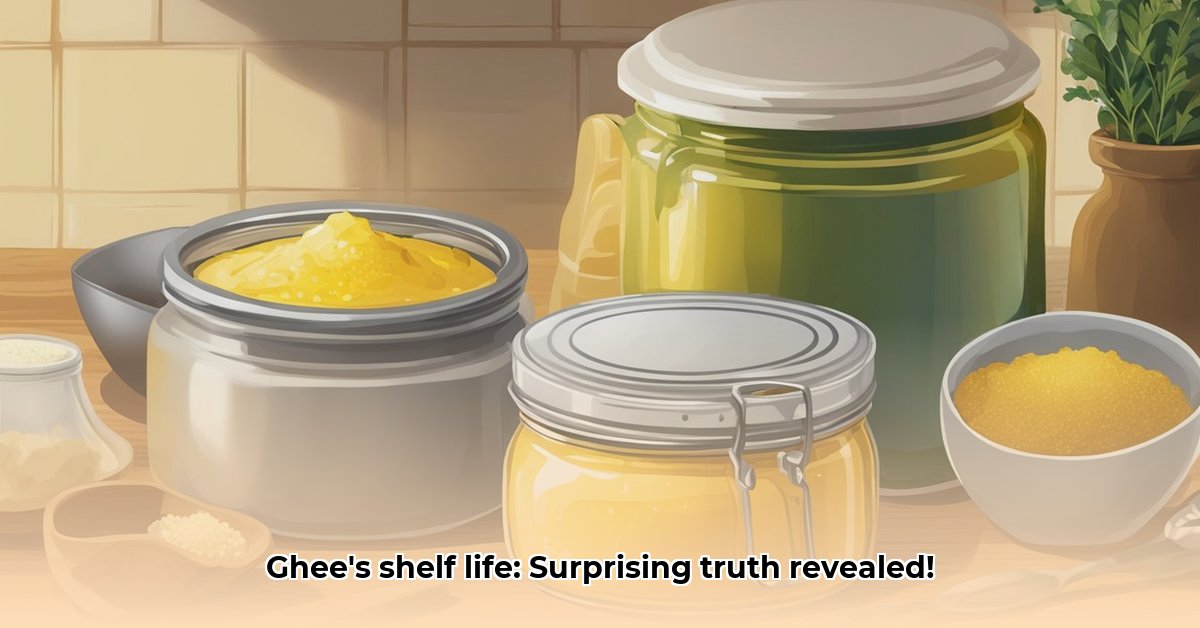Ever wonder if your ghee is still good? We’ve all been there, staring at a jar of that golden goodness, questioning its shelf life. This guide will clear up any confusion about how long ghee lasts and how to store it properly so you can enjoy every delicious drop. We’ll cover everything from how ghee spoils to the best ways to keep it fresh – whether you’re a ghee newbie or a seasoned pro, this guide has you covered. Just like understanding the shelf life of ghee, it’s helpful to know that [even water can spoil](https://chaztin.com/can-distilled-water-go-bad/).
Ghee’s Shelf Life and Storage: What You Need to Know
Let’s talk ghee! This clarified butter is a kitchen staple for many – and for good reason. It boasts a rich flavor and a surprisingly long shelf life. But does it ever go bad? The short answer is yes, eventually. However, understanding how ghee spoils and how to store it properly can help you enjoy its deliciousness for months, even years. Ghee’s unique properties, like its low moisture content, make it a resilient ingredient.
The Secret to Ghee’s Shelf Life
Unlike regular butter, ghee doesn’t contain water or milk solids. These are the main ingredients that make butter spoil quickly. The absence of water and milk solids is ghee’s superpower; it significantly slows down the spoilage process. Think of it like this: you’d expect a juicy steak to go bad faster than a well-dried piece of jerky. Ghee is the jerky of the butter world! Understanding the composition of ghee is essential for extending its usability.
How Ghee Spoils: Rancidity Explained
The primary way ghee goes bad is through a process called rancidity. Don’t worry, this isn’t about bacteria growing and causing illness. Rancidity is about the breakdown of the fats within the ghee. Over time, exposure to air, light, and heat causes these fats to oxidize – basically, they react with oxygen. That’s what causes the unpleasant changes. Imagine leaving a can of paint open for months – eventually, its color, texture, and smell start to change, right? It’s a very similar process. You’ll likely notice:
- A change in smell: Rancid ghee smells off – often sharp, sour, or even a bit bitter, like old paint. It might even remind you of a chemical smell.
- A distinct change in taste: Its once-delicious flavor will become harsh, unpleasant, and bitter.
- A visible change: You might notice a change in its color – it might become cloudy, whiter, or even separate into layers. This is a clear indication that things aren’t right.
Factors Affecting Ghee’s Shelf Life and Longevity
Several things can impact how long your ghee remains fresh and flavorful. Let’s look at the key players that affect ghee quality:
- Homemade vs. Store-bought: Homemade ghee, due to variations in the clarifying process, might contain trace amounts of milk solids that could lead to slightly faster spoilage when compared to commercially made ghee.
- Storage Location and Temperature: Where you keep your ghee makes a HUGE difference. Room temperature, the fridge, or the freezer all have their own pros and cons.
- The Quality of the Starting Butter: You get what you put in! Ghee made from high-quality, unsalted butter will generally last longer and taste better. Impurities affect the final outcome tremendously.
- Packaging is Key: Airtight containers are truly the best way to go! They protect the ghee from oxygen, which is a major factor in rancidity. Think of it like keeping your potato chips in a sealed bag; it preserves their freshness much better than leaving them open in a bowl.
Spotting Spoiled Ghee: Trust Your Senses for Freshness
The most reliable way to tell if your ghee has turned is to use your senses. This is more precise and trustworthy than any date printed on the container. Always consider sensory clues for ghee freshness.
- Smell: If it smells even slightly off, it’s time to let it go. Don’t take any risks.
- Taste: A single taste test can tell you all you need to know. If it tastes sour, bitter, or just “off,” then toss it.
- Appearance: Changes in color or texture (separation, clouding) often means the beginning of the end.
When in doubt, throw it out! Better safe than sorry.
Storing Ghee Like a Pro: A Step-by-Step Guide
Here’s how to keep your ghee fresh for as long as possible. We’ll tackle different storage options to suit your needs:
Step 1: Choose the Right Container: Opt for an airtight, dark-colored (opaque) container made from glass or stainless steel. These materials are least likely to affect the flavor or quality of the ghee.
Step 2: Short-Term Storage (Up to 6 Months): A cool, dark pantry or cupboard will do. Keep it away from heat sources and direct sunlight.
Step 3: Medium-Term Storage (6-12 Months): Refrigeration significantly extends ghee’s lifespan. Storing it in the fridge will keep it fresh for longer. Note that refrigeration might slightly change its texture, making it firmer.
Step 4: Long-Term Storage (Over 1 Year): The freezer is your friend for long-term storage. Use freezer-safe containers and ensure an airtight seal. Let it come to room temperature before using. Remember, even frozen ghee can go rancid eventually, though at a much slower rate.
Optimizing Ghee Storage: Weighing the Pros and Cons
Here’s a quick rundown of the advantages and drawbacks of each storage method:
| Storage Method | Pros | Cons |
|---|---|---|
| Room Temperature | Convenient, maintains original texture | Shorter shelf life, higher risk of spoiling quickly |
| Refrigeration | Significantly extends shelf life | May slightly alter texture, requiring some adjustment |
| Freezing | Longest shelf life, best preservation | Requires extra steps, may slightly change texture |
Frequently Asked Questions (FAQ) on Ghee Usage
- Q: Can I reuse ghee after cooking with it? A: Absolutely! Provided it doesn’t show any signs of rancidity (off smell, taste, or appearance).
- Q: What about the “best by” date on the ghee jar? A: These dates are usually quite conservative. It’s always best to rely on your senses to determine the ghee’s freshness.
- Q: Is it safe to use ghee if it smells slightly “off”? A: No. If you notice anything unusual, discard it immediately.
The Final Word on Ghee and Spoilage Prevention
While ghee does eventually go bad, its remarkable keeping quality, when stored properly, is a real benefit. By following these simple tips, you’ll maximize its shelf life and continue to enjoy its wonderful flavor and culinary versatility. Remember, your senses are your best guides! With proper storage techniques, ghee’s shelf life can be maximized.
How to Tell if Homemade Ghee Has Gone Rancid
Key Takeaways:
- Ghee, clarified butter, lasts much longer than regular butter due to its low moisture and lack of milk solids.
- However, even ghee can spoil, turning rancid.
- Proper storage is key to extending its shelf life.
- How to tell if homemade ghee has gone rancid involves checking its aroma, taste, and appearance.
- Discard ghee exhibiting any signs of spoilage.
Understanding Ghee Spoilage Indicators
Does ghee go bad? Yes, although its shelf life is impressively long. The culprit? Rancidity. This occurs when the fats in ghee break down, typically through oxidation, resulting in off-flavors and odors. Think of it like a slow rusting process for your fat. The process is sped up by exposure to light, heat, and air. Is your ghee still in good condition?
Factors Affecting Ghee’s Longevity and Degradation
Several factors influence how long your ghee remains fresh. Homemade ghee, often containing more residual milk solids, spoils faster than commercially produced varieties. Storage conditions play a crucial role. Imagine your ghee as a delicate flower – protect it from the harsh sun and fluctuating temperatures.
| Factor | Impact on Shelf Life |
|---|---|
| Type of Ghee | Homemade ghee spoils faster than commercial ghee. |
| Storage Temperature | Cool, dark places are best. Refrigeration extends shelf life, freezing even further. |
| Quality of Starting Butter | High-quality, unsalted butter yields higher-quality, longer-lasting ghee. |
| Packaging | Airtight containers are essential to prevent oxidation and contamination. |
Identifying Rancid Ghee: The Sensory Check
How to tell if homemade ghee has gone rancid is simple: use your senses!
- Smell: A pungent, sour, or bitter aroma strongly suggests rancidity. It might even resemble paint thinner. Trust your nose; if it smells off, it’s probably off.
- Taste: Rancid ghee will have a noticeably sour, bitter, or unpleasant taste. A tiny taste test is all you need. Don’t hesitate
- Gluten Free Meal Prep Ideas for Delicious, Hassle-Free Eating - November 28, 2025
- Gluten Free Meal Prep for Stress-Free and Healthy Eating - November 27, 2025
- Quick And Easy Chicken Thigh Meal Prep For Weight Loss - November 26, 2025










